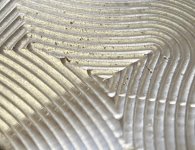Matt@RFR
Titanium
- Joined
- May 26, 2004
- Location
- Paradise, Ca
Gentlemen. Haas VF-2ss. I'm working on some 6AL4V parts that have very shallow (about 12º max from horizontal) and I'm getting welded chips in the finish pass. The finish itself is great aside from the welded chips. Not torn at all. I made the exact same parts out of a nasty batch of 304 with zero issues earlier today, same setup, same tooling, etc. Coolant is in excellent shape and at 8% (1% over nominal). Runout is less than .0003".
Everything else about the parts is working great. Finishes and sizes are perfect, it's just this shallow surface that is having issues.
Roughing with a 3/8" 5 flute endmill leaving .005" (as programmed), semi finish with identical tool as the finisher (1/8" 4 flute AlTiN coated Imco ball nose.) leaving .002". .028" stepover for both 1/8" ball nose tools. Parts are highly cosmetic and the customer requested this stepover to get a pattern. All the welded chips look to be on the conventional milling side, which of course makes perfect sense.
I'm at 12,000 RPM, which should be 97 SFM at my calculated effective tip diameter of .031". 50 IPM. I tried 6,000 RPM and 25 IPM for shits, and really nothing changed, which was surprising.
Two brand new tools made no change.
Any thoughts?
Here's one at 171x:

And a normal picture:

Everything else about the parts is working great. Finishes and sizes are perfect, it's just this shallow surface that is having issues.
Roughing with a 3/8" 5 flute endmill leaving .005" (as programmed), semi finish with identical tool as the finisher (1/8" 4 flute AlTiN coated Imco ball nose.) leaving .002". .028" stepover for both 1/8" ball nose tools. Parts are highly cosmetic and the customer requested this stepover to get a pattern. All the welded chips look to be on the conventional milling side, which of course makes perfect sense.
I'm at 12,000 RPM, which should be 97 SFM at my calculated effective tip diameter of .031". 50 IPM. I tried 6,000 RPM and 25 IPM for shits, and really nothing changed, which was surprising.
Two brand new tools made no change.
Any thoughts?
Here's one at 171x:

And a normal picture:


